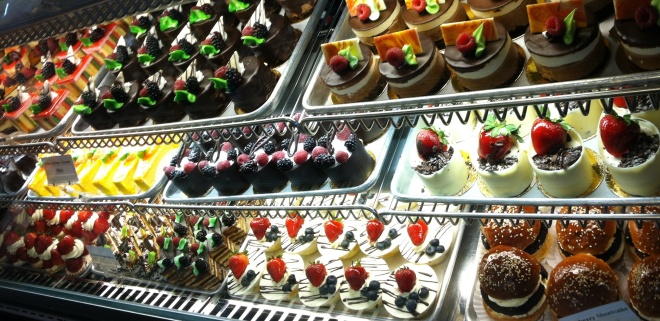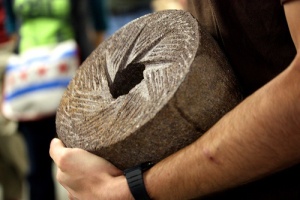Even som eone with a Ph.D.…no one knows everything!” says James Tran in a hopeful, light-hearted tone during the beginning of our Culinary Guild tour Friday morning. Tran, a 39-year-old native of Vietnam, has spent the last two years in endless trial and error scenarios attempting the first shrimp farm in Massachusetts. Mainly a three-person team, along with frequent consultants and some investors, Tran combined his engineering background, his upbringing in the family shrimp business, and his entrepreneurial spirit to develop a method of shrimp farming that is sustainable, natural and chemical-free for the shrimp, and aims to have no environmental impact or disruption to Stoughton, the hatcheries, and New England’s coastal areas. We are happy to report that thus far, his goals and passion are slowly coming to fruition.
eone with a Ph.D.…no one knows everything!” says James Tran in a hopeful, light-hearted tone during the beginning of our Culinary Guild tour Friday morning. Tran, a 39-year-old native of Vietnam, has spent the last two years in endless trial and error scenarios attempting the first shrimp farm in Massachusetts. Mainly a three-person team, along with frequent consultants and some investors, Tran combined his engineering background, his upbringing in the family shrimp business, and his entrepreneurial spirit to develop a method of shrimp farming that is sustainable, natural and chemical-free for the shrimp, and aims to have no environmental impact or disruption to Stoughton, the hatcheries, and New England’s coastal areas. We are happy to report that thus far, his goals and passion are slowly coming to fruition.
In a bare bones industrial park, lined with modestly staggered rows of brick buildings, Tran has nearly exhausted the space of his intimate shrimp farming facility from five tanks to eight tanks, and counting. Growing four different sizes of shrimp, he hopes to further expand his warehouse to answer the local restaurant demand for his gourmet Pacific White shrimp. Utilizing a zero water exchange facility, Tran takes fresh Atlantic Ocean water, trucked in from the coast of New Hampshire at high tide, and recycles this salt water after each consecutive shrimp crop. With high technology advanced recirculation, filtration, and temperature control systems, Tran can oversee every step of shrimp growth and has the ability to send messages to his phone if there is a problem with the tanks.
Tran engineered his own three-stage process controller system including advanced recirculation, filtration, and close temperature regulators, while others in the shrimp farming business use an unsuccessful one-stage method. He finds this to be more successful and efficient, while keeping with his goals to remain environmentally sound and have a lower carbon footprint. With regulation of salinity levels and warmer water temperature, the shrimp can sell to market in 85-90 days. Waste is incredibly low from the implementation of denitrification and mesh filters, allowing an annual total waste byproduct from the shrimp tanks at an average of 2 inches. Even more low impact, Tran’s shrimp grow in water around 82-83 degrees F, so this heated environment also supplies heat to their building and warehouse.
Sourcing their shrimp larvae from an FDA certified hatchery in Florida, Tran knows that he is purchasing from a very controlled environment. From larvae size, which is smaller than a mosquito, it takes about 12 days for the shrimp to grow to about one inch in size. Throughout the tour as we listened to Tran and his team speak about the shrimp, their vision and desire to respect the shrimp and bring a new perspective overall to the shrimp farming industry is inspiring. Multiple times, Tran expressed that when they are harvesting the shrimp from the tanks, he never wants to stress them out. They are never frozen and are only delivered directly to restaurants on ice without the use of any preservatives or chemicals.
His optimum goals are to develop more circular tanks for easier net harvesting, providing more room in the tanks for the shrimp, and one day to build his own hatchery and feed the shrimp with a 100% vegetarian feed. The “8” in Sky8 may mean that James Tran started the eighth shrimp farm in the U.S., but it is also the luckiest number in Chinese culture. From witnessing disasters like Hurricane Katrina and the Gulf oil spill that have nearly destroyed shrimp ecosystems, James Tran is ready to take on the challenge and provide the shrimp industry with an ecologically responsible, local source for freshly grown seafood.
Jillian Bernardini
www.jilleats.com
































